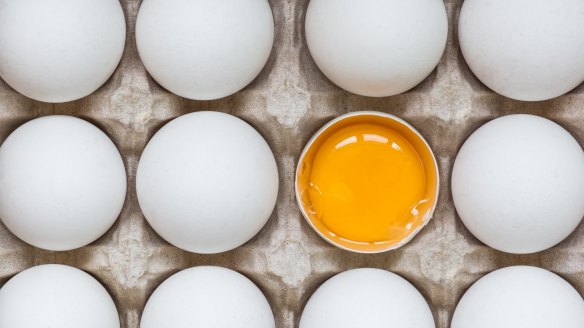The best way to crack an egg

What's the best way to crack an egg so as to avoid mess and pieces of shell in the dish? L. Tullberg
We used to have a chook that, no matter how much shell grit we forced into her, still laid eggs without shells. If chickens could smile, I reckon she wore a bemused one on her beak each time she passed a wobbly little sack. When baking my grandmother would always break eggs into a cup before using them. This meant that any off eggs - there seemed to be more of them in the old days - could be chucked and any bits of broken shell could be retrieved. This she did by using the shell to fish the piece of shell out as the broken fragment sticks more easily to the shell. I went through several dozen eggs to test a few theories. Cracking an egg on a bowl or a sharp surface is a popular method. But it punctures the membrane and means the albumen starts leaking out straight away. A better, although not foolproof method, is to crack the egg on a flat surface, striking the egg on its equator where the shell is the weakest. Do this with just enough force to shatter a small portion of the shell in one blow, then place thumbs either side of the cracked section and lever open the egg. This works without leaking egg white or splintered shell dropping off (as the shell is still attached to the membrane) most of the time. Other than these, I have never found a foolproof way of avoiding shell in eggs other than buying frozen eggs in a carton.
What do I with parmesan cheese rinds? H. Scovell
Think of parmesan as a cheesy stock cube. It's all about the salt and umami. Parmigiano-Reggiano is made from cow's milk in large wheels that are matured for a minimum of 12 months. During this time proteins are broken down by enzymes that form during fermentation. Those enzymes break down the milk proteins into amino acids. One of them is glutamic acid - we detect it on our tongue as yumminess, delicious or, as the Japanese say, umami. After eight months the amount of glutamic acid is around 180mg per 100g. After 24 months in the aging rooms a really well-aged parmesan can packing a whopping 1600 milligrams or 100 grams of glutamic acid. Add leftover rinds to minestrone, tomato sauces and stews, removing before serving. Simmer it with your chicken stock for a rich zuppa pavese - broth topped with bread and parmesan. You can put the rinds in a jar and cover with extra virgin olive oil to make parmesan-infused oil. Parmesan cheese makes everything more delicious.
Neil Perry's special fried rice recipe calls for yellow bean sauce. Where do I find it? C. McGeachie
Sometimes called Chinese yellow bean paste or huang jiang, it's a combination of fermented soy bean, flour, salt and sugar, and is often used in noodle dishes, stir-fries and marinades. You can find it in jars at supermarkets and Asian grocers. It should be refrigerated after opening.
Letters
In this column recently we discussed using excess basil. A few of you responded with suggestions. J. Fowler wrote, "I make pesto and freeze it and six months later it thaws out like fresh pesto. I also sometimes add pomegranate molasses to my pesto as a variation, known as pom-bas in our house." N. Major chipped in with, "I usually have much more basil than needed at the time, so I place it in Ziploc bags, squeeze the air out and seal, then freeze. Probably not best for salads, but so good in cooking or pesto, straight from the pack."
Send your vexing culinary conundrums to brainfood@richardcornish.com.au or tweet to @realbrainfood.
- More:
- Food
- Brain food
